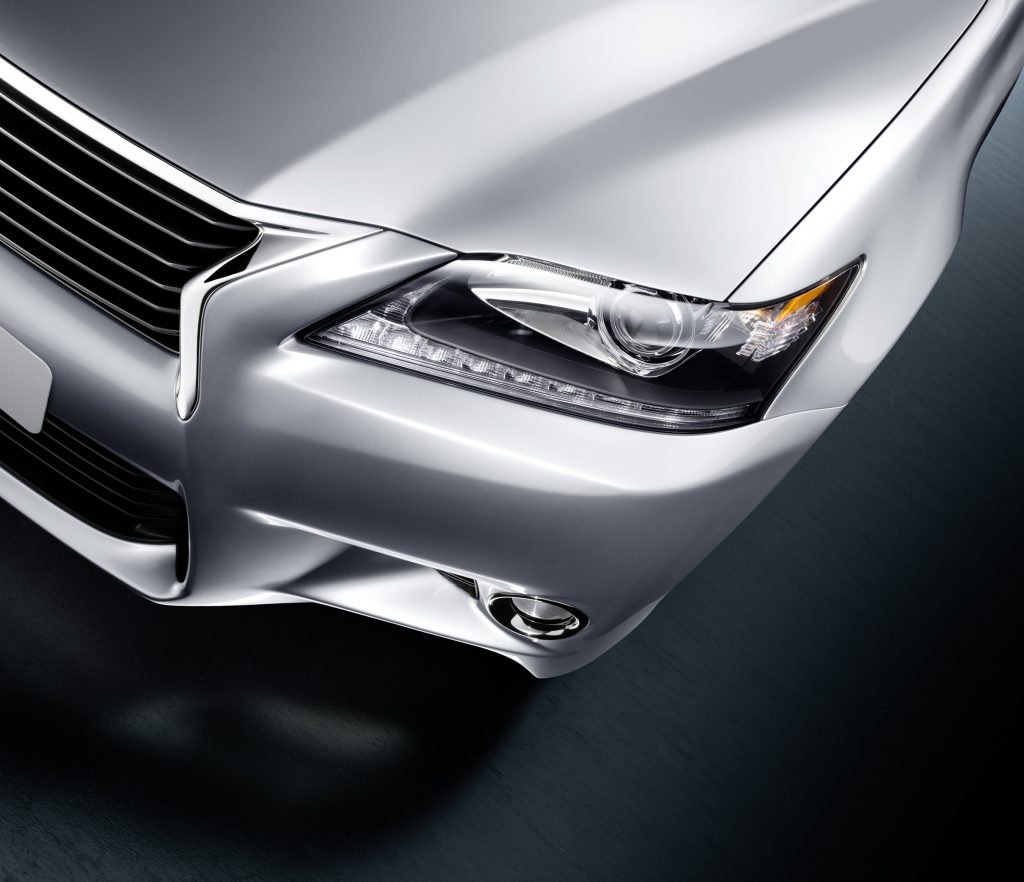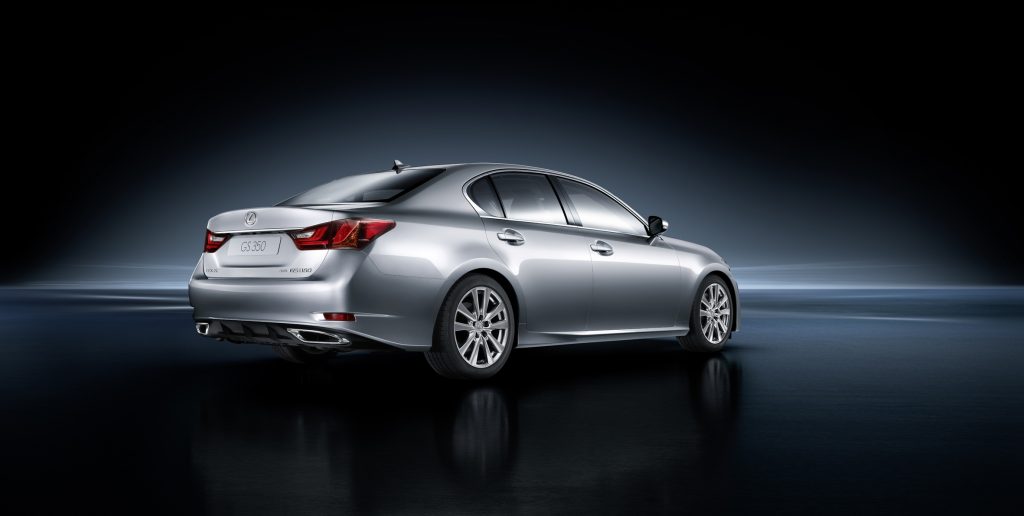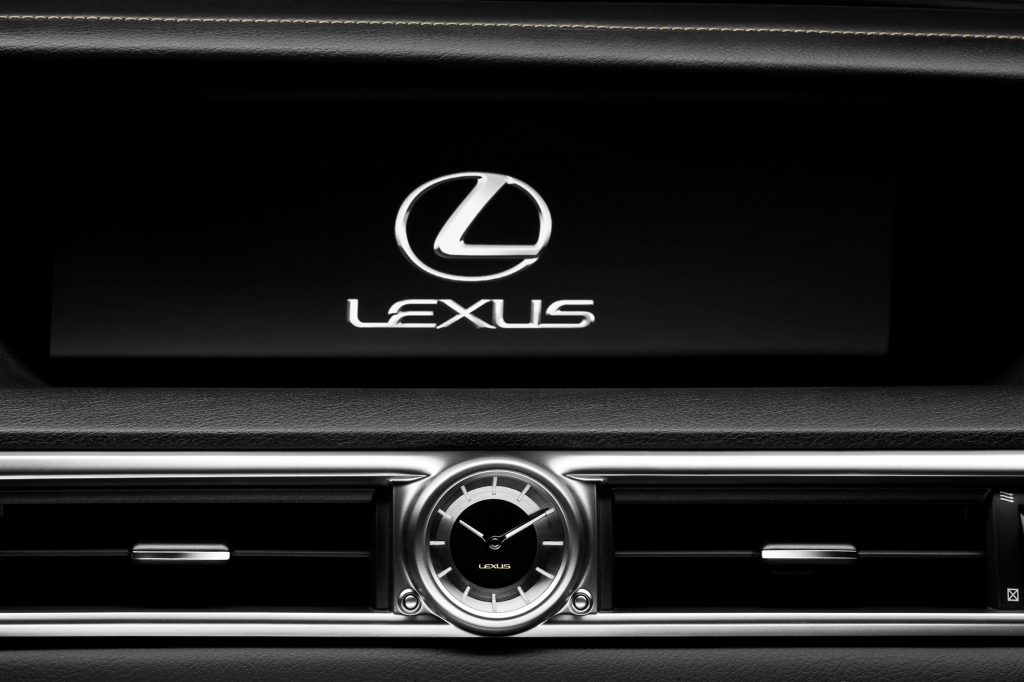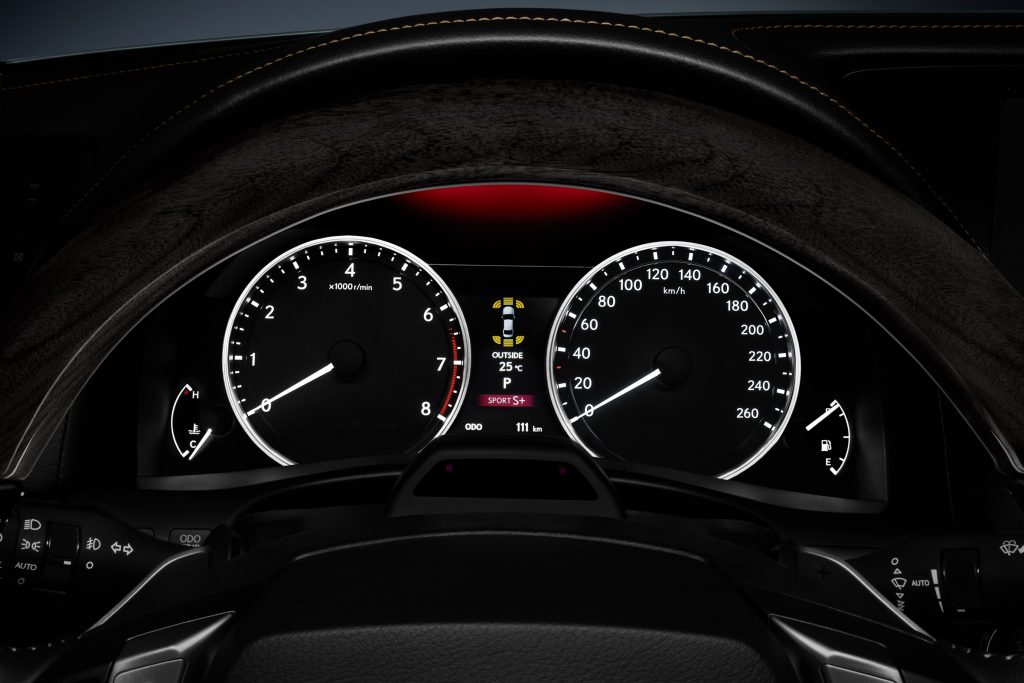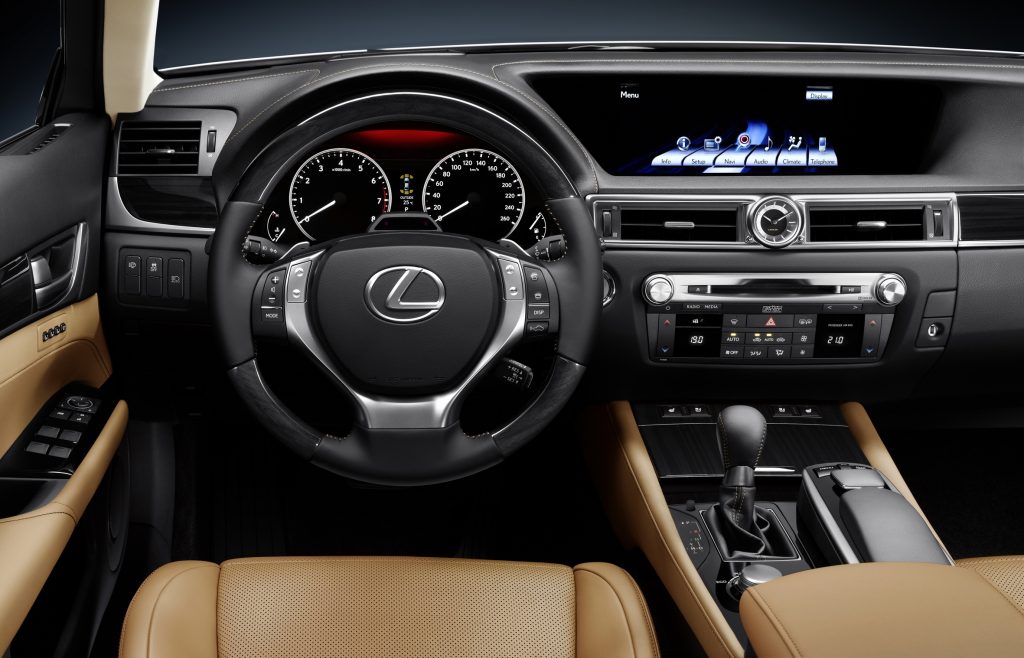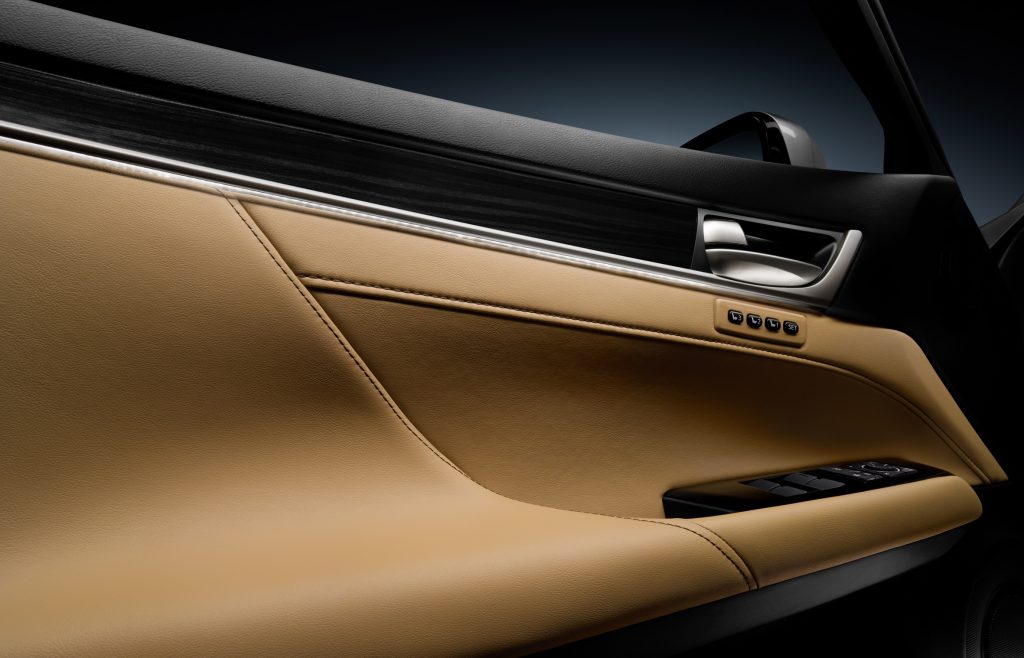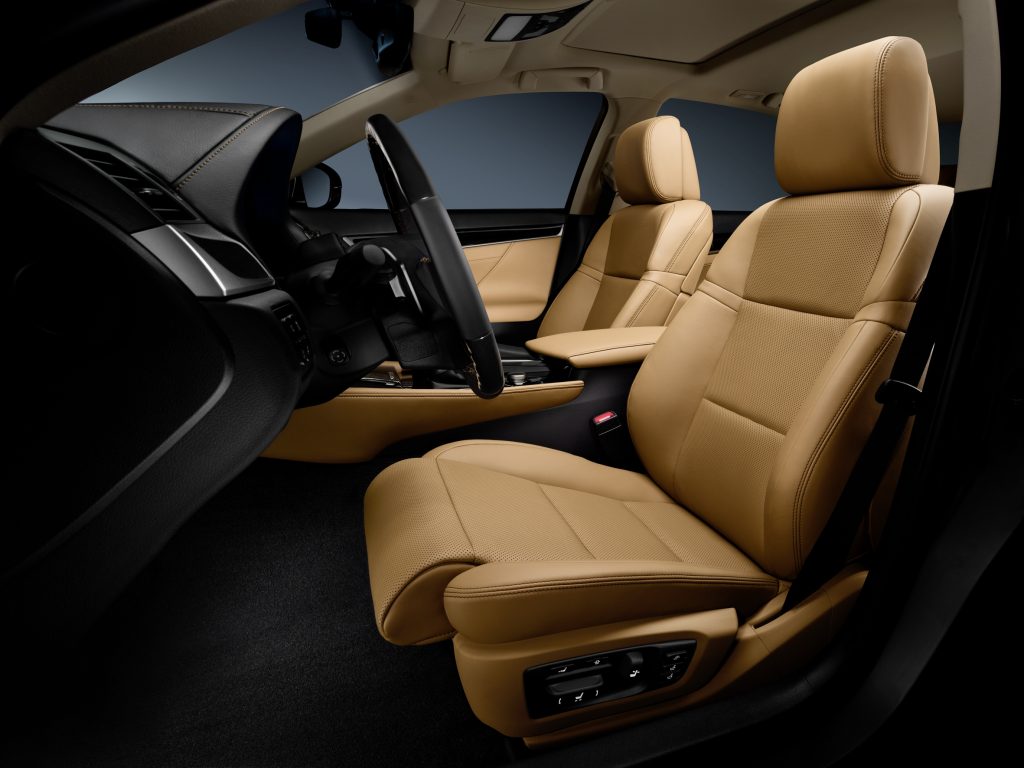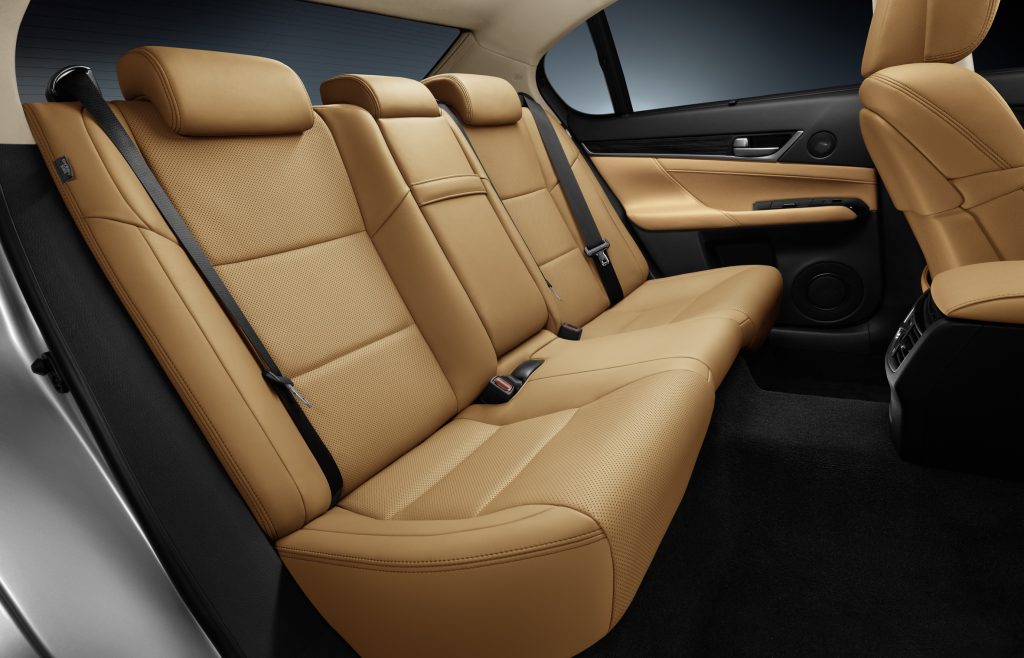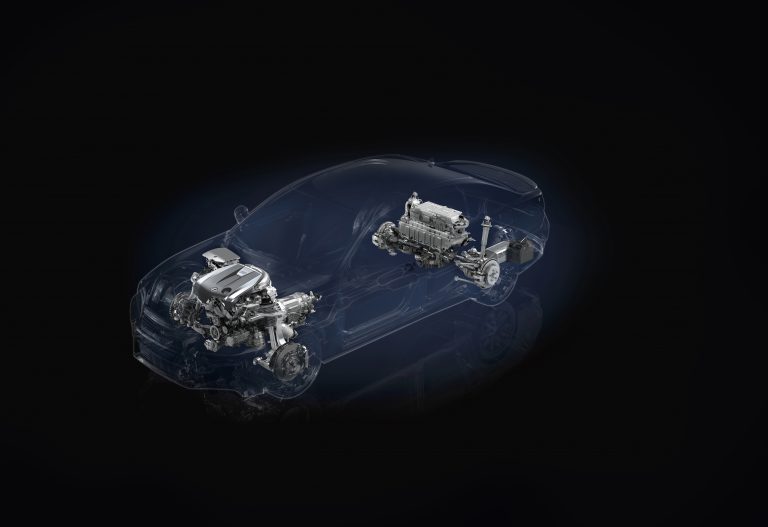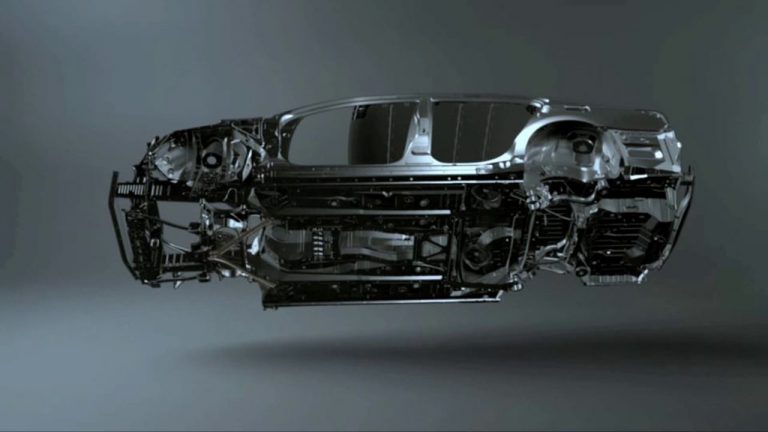World Premiere of the Lexus GS 450h
DESIGN AND PACKAGING
- Next generation L-finesse design with Lexus trademark ‘spindle’ grille
- Future Lexus interior with driver-focused cockpit and advanced Human-Machine Interface (HMI) technologies
- Increased head and legroom for all occupants, and increased luggage space
- Elegant, contemporary interior design with hand-crafted quality feel
- World’s largest (12.3-inch) multi-information display screen and second-generation Remote Touch Interface (RTI)
- New, energy-saving air conditioning system with S-Flow and ‘Nano-e’ technologies
EXTERIOR DESIGN
The fourth-generation GS has an all-new exterior that reflects further development of Lexus’s L-finesses design philosophy, giving the car a bolder and more dynamic appearance.
Key to the new design is a strong frontal treatment which gives the car a commanding road presence that is appropriate for a Lexus performance saloon.
In an evolution of a styling cue first developed on the CT 200h, the inverted trapezoid upper grille and slanted lower grille have been combined in a single element, bridging the middle of the bumper to create a prominent ‘spindle’ shape. The positioning of the brake cooling ducts to either side of the spindle grille add to the distinctive look, as well as being functional.
This individual treatment makes the new GS instantly recognisable as a Lexus and it will be adopted throughout the model range to strengthen the brand’s family identity.
The grille is flanked by headlamp clusters set on a higher plane than the grille itself. A characteristic unique to Lexus models, it focuses the eye at the apex of the vehicle, giving the design a resolute look. The headlamps themselves are underscored by new, integral LED Daytime Running Lights (DRL) which for the L-finesse arrowhead motif, adding to the GS’s unique visual signature.
The deep front bumper features sharply sculpted foglamp housings and forms a wide, trapezoid shape that anchors the muscular front wings and flared wheelarches, reinforcing the new model’s wider front track, broad stance and powerful road presence.
In profile, the new GS shares its predecessor’s long, elegant cabin proportions, but a 15mm increase in the height of the roofline allows for more rear passenger accommodation and boot space. The shape remains aerodynamically efficient, with a drag coefficient of Cd 0.26.
To the rear, the new design narrows behind the flared wheelarches, exposing the lower part of the rear tyres to emphasise the wide rear track. The LED lamp clusters have aero-stabilising fins that add to the car’s overall aerodynamic efficiency. Another unique feature, the rear bumper covers the exhaust pipe apertures.
As well as the new headlamp design, the new GS 450h can be identified by its hybrid specific front, rear and side blue badging.
INTERIOR DESIGN
Lexus has developed the new interior to provide a driver-focused cockpit and an environment that will help keep the driver alert and all occupants comfortable when travelling for long periods of time.
The cabin represents a continuation of the next-generation Lexus interior design theme that was introduced with the CT 200h, combining outstanding ergonomics with advanced HMI technologies.
Driver-focused cockpit
A clean, elegant dashboard forms a wide horizontal plane that emphasises the roominess of the interior, while the door and centre console trims help create a cocoon-like environment for the driver and front passenger.
The dashboard is divided into two distinct zones: an upper Display Zone, which features a 12.3-inch, LCD multi-display screen – the largest yet fitted in a passenger car, and a lower Operation Zone, with system controls such as the second generation of Lexus’s award-winning computer mouse-style Remote Touch Interface (RTI).
Every aspect of the driving position has been carefully considered to determine the ideal placement of controls, maximise comfort and minimise driver distraction and fatigue.
A new front seat has a lower hip point, placing the driver closer to the car’s centre of gravity. It combines the best possible body-holding with excellent comfort. There is an extended seat slide range to help as wide a cross-section of occupants as possible find a comfortable driving position. As well as a new mid-seatback folding adjustment, the seats have multiple adjustment mechanisms, including a butterfly-style headrest, shoulder support, side support, four-way lumbar support and an adjustable cushion length.
Soft padded, tactile finishes to the centre console arm rest, knee pads and door arm rests add to the comfort of the driving position.
The steering wheel has an extra 50mm of reach adjustment and has been set at a low angle to make it easier for the driver to make larger steering inputs without having to over-reach. Even the cross-section of the wheel has been scrutinised: it is no longer uniform through the entire circumference, but has a varying profile for a relaxing grip and smoother inputs.
The brake pedal, too, has been redesigned, with a new pedal shape and surface angle and footrest increased to 300mm for greater comfort.
The driver’s instrument binnacle incorporates high-visibility, large diameter Optitron dials. To minimise the time the driver has take his or her eyes off the road ahead, a new Head-Up Display has been introduced, relaying essential information such as gear shift position, tachometer and navigation instructions on to the base of the windscreen, in the driver’s line of sight.
Forward visibility has been maximised by designing slimmer A-pillars and a taller windscreen, creating a wider field of view. Even the bonnet visibility range has been tailored so that the driver can easily locate the vehicle’s extremities, making it easier to manoeuvre the car in tight spaces.
Comfort, convenience and contemporary craftsmanship
Although the new GS 450h’s wheelbase is the same length as that of its predecessor, there is more space and comfort inside for everyone. Front and rear door openings have been designed for easier access, with a particular focus on head clearance.
The front seats have a new seatback design that is more comfortable for taller occupants. A greater seat sliding range and height adjustment give more legroom and up to 30mm of extra headroom.
The rear seats have a revised seatback angle and redesigned cushion shape for greater comfort. The thin front seat design improves knee room by 10mm, and headroom has been increased by 20mm.
The new GS has a more practical boot, thanks to a more compact rear suspension layout, a wider opening, increased deck length and lower deck height. These measures, together with the repackaging of the hybrid battery in a stacked format, combine to increase luggage capacity to 450 litres.
The traditional two-tone interior colour scheme has been replaced with a more versatile palette: the dashboard, floor and steering wheel are a uniform black, with grey or ivory stitching on the leather instrument panel, according to the choice of interior tone.
In a world first, customers can choose a real bamboo finish for the steering wheel, symbolic of the innovative spirit and environmental credentials of the GS 450h’s Lexus Hybrid Drive system.
The cabin’s air of sophistication and luxury is reinforced by Lexus’s painstaking attention to detail, with finely crafted details such as satin metal trims, high quality stitching and brushed aluminium knobs on the audio system. Another special feature is a new analogue clock with LED indicators, created from a single ingot of metal.
The quality features of the interior are complimented by an all-white LED lighting system, with sequenced illumination that begins as occupants approach the car, even before it is unlocked, and continues through the vehicle start procedure.
INNOVATIVE ON-BOARD TECHNOLOGIES
The new GS introduced several innovative technologies, including a new energy-saving air conditioning system, second-generation RTI linked to the world’s largest in-car multi-information display and a choice of audio systems the offer unparalleled power and clarity.
Second-generation RTI with 12.3-inch multimedia display
Lexus’s second-generation RTI multi-function control has been made easier to use with the introduction of a planar slide-type controller that is much like a computer mouse. The ‘enter’ command is now made simply by pushing the controller. Usability has also been improved by minimising the difference in height between the RTI controller and the armrest.
RTI lets the user move the cursor quickly and easily across the 12.3-inch multimedia display. The largest in-car unit of its kind, it features a full-colour LED screen with an ultra-wide 24:9 format. The screen’s size means there is room for two types of information to be displayed at the same time, such as map/audio, night view/map and navigation input/incoming call.
S-Flow air conditioning with ‘Nano-e’ technology
The new air conditioning unit is 10 times more powerful than that used in the previous GS and uses S-Flow technology to maintain cabin comfort while significantly reducing power consumption. Using sensors to determine which seats are occupied, it automatically closes all vents serving unoccupied seats to reduce ventilation losses.
In addition, the system automatically shifts to an ECO mode when the ECO drive mode is selected, switching on the seat heaters in order to reduce the amount of power needed to bring the cabin up to a comfortable temperature.
The air conditioning incorporates a new ‘Nano-e’ technology system, an air cleaning technology that operates automatically when the system is turned on. It releases 20 to 50-nanometre diameter ‘Nano-e’ particles – negatively charged ions wrapped in water molecules – into the cabin through the air vent on the driver’s side of the dashboard. By attaching themselves to airborne particles and molecules, these ‘Nano-e’ ions can have an air purifying and deodorising effect. They can also remove smells from the upholstery and rooflining to create a cleaner cabin environment.
In addition, because ‘Nano-e’ moisture content is approximately 1,000 times that of conventional ions, there can also be a moisturising effect on skin and hair.
Audio systems
Two audio systems are available for the new GS 450h. The standard system represents the next generation of realism and clarity in Lexus sound, with a fully digital Class-D amplifier that can create virtually distortion-free sound with minimal voltage losses. The natural sound dynamics and rich harmonies generated by the high-definition amplification are faithfully reproduced by an enhanced, 12-speaker arrangement, which features a new, front three-way system.
The new, top-of-the-range, 17-speaker Mark Levinson Premium Audio system creates sound based on the concepts of Effortless Dynamics and Effortless Transient Response, which combine natural dynamics with high response and tracking performance to offer sound quality equivalent to that of a live concert hall performance.
It features a new, Generation III ML5 amplifier, which generates 125W per channel and a total of 835W (75W and 505W more power respectively than the current system), while consuming just 6.5 Amps – less than a quarter of the power consumed by the current generation system.
Developing twice the volume for the same power consumption, GreenEdge power-saving technology has been incorporated into all 17 speakers. This technology covers a wider frequency than conventional systems, giving a better dynamic range.
The new Mark Levinson system has five new 90mm GreenEdge Unity speakers with a coaxial structure that integrates mid and high-range units within the same structure. The all-round cabin positioning of these speakers gives consistent timbre for both front and rear seat occupants, resulting in a whole new level of surround sound, definition, atmosphere and quality.
ENGINE AND TRANSMISSION
- GS 450h with second-generation Lexus Hybrid Drive system
- GS model range to expand further with additional variants in the near future
- New Atkinson cycle V6 petrol engine with cooled Exhaust Gas Recirculation (EGR) and Exhaust Heat Recovery (EHR)
- Eighteen per cent improvement in fuel consumption to 44.8mpg, CO2 emissions now below 145g/km
The introduction of the new GS 450h and, in some markets, the GS 350 AWD, marks the start of a period of expansion of the Lexus GS range with additional variants to be introduced in the near future.
The GS 450h is equipped with a second-generation Lexus Hybrid Drive system, reinforcing the company’s commitment to the future of full hybrid drive technology. With comprehensive improvements to every aspect of its powertrain, the new GS 450h offers significant reductions in fuel consumption and CO2, NOx and PM emissions, with no loss of performance.
Total system power output is 338bhp (252kW) and 345Nm of torque, enabling the GS 450h to accelerate from nought to 62mph in 5.9 seconds and reach a maximum speed of 155mph. At the same time, fuel consumption has been improved by 18 per cent to 44.8mpg and CO2 emissions have fallen below 145g/km.
Lexus Hybrid Drive system architecture
Like every Lexus hybrid vehicle, the new GS 450h is a full hybrid, capable of operating in both petrol or electric modes alone, as well as combination of both. Its Lexus Hybrid Drive system features an ultra-smooth 286bhp (213kW) 3.5-litre V6 petrol engine mated to a compact, high-output, water-cooled permanent magnet electric motor. The engine and electric motor work together to drive the rear wheels, or the electric motor can do so alone.
The system also comprises a generator, a high-performance nickel-metal hydride battery, a power split device which, via planetary reduction gears, combines and re-allocates power from the engine, electric motor and generator according to driving requirements, and a compact power control unit to govern the high-speed interaction of the system components.
3.5-litre Atkinson cycle V6 engine
The 3.5-litre DOHC V6 petrol engine has been adapted specifically for use in the hybrid powertrain with several technical improvements. It adopts the Atkinson cycle, Exhaust Gas Recirculation and Exhaust Heat Recovery to optimise the fuel efficiency benefits of Lexus Hybrid Drive.
With conventional four-cycle petrol engines, there are times when fuel enrichment is required to cool the exhaust gases and prevent degradation or destruction of the catalytic converters. Because the intake valves close late in an Atkinson cycle engine, compression is delayed. This creates a high expansion ratio for less compression, reducing intake and exhaust energy losses and converting combustion energy to engine power more effectively. As a result, the exhaust temperature is lower than that of conventional engines.
The EGR system reintroduces precisely metered exhaust gas into the intake system, via a bespoke delivery manifold. This further reduces engine operating temperatures, while also reducing engine pumping losses through a decrease in intake vacuum pressure.
Together, the adoption of the Atkinson cycle and cooled EGR minimise the situations where the cooling effect of fuel enrichment is necessary to protect the catalytic converter from overheating damage, thereby improving fuel economy and lowering emissions.
The EHR system uses exhaust gas heat to warm the engine coolant at start-up. This shortens engine warm-up time, allowing it to be shut off earlier for increased electric motor-only operation, particularly in winter. As a result, the new GS 450h achieves a marked increase in cold weather efficiency compared to its predecessor.
Further reductions in fuel consumption have been achieved through a high physical compression ratio of 13.0:1; a new, mid-port intake tumble generator; and the adoption of next-generation D-4S direct injection technology.
D-4S is the latest evolution of Lexus’s stoichiometric, four-stroke, direct injection technology. With one injector in the combustion chamber and a second mounted in the intake port, it combines the strengths of both direct and port injection, realising the best possible engine efficiency throughout the power band and improving torque across the rev range, while minimising fuel consumption and emissions.
The system features new slit-type injector nozzles with a modified port shape, a higher fuel pressure for more efficient combustion and idle port injection for improved NVH characteristics.
Engine noise, vibration and friction have been lowered by using lightweight chain technology, a piston pin offset change and a reduction in the number of drive belt reinforcement ribs.
Engine durability has been improved, too, through the removal of all external oil lines, and environmental performance has been strengthened by the use of a new-specification catalyst that contains much less precious metal.
Additional hybrid system component improvements
The Power Control Unit’s (PCU) cooling performance has been improved by the adoption of dual cooling paths and a single-piece, integrated AC/DC converter.
System control has also been improved: the PCU boosts motor drive voltage to a maximum 650V in Sport mode, and limits it to a maximum 500V in Eco mode for more environmentally efficient performance.
The electric motor has lighter mounts and a reduction in friction, and the system’s regenerative braking operation range has been increased, which further contributes to improvements in fuel efficiency.
Also, the battery layout has been redesigned, the new stacked configuration helping increase the amount of luggage space in the boot.
DRIVING DYNAMICS
- Rigid bodyshell and new suspension for agility, stability and ride comfort
- Active Variable Suspension further contributes to ride quality, stability, body control and steering response
- Drive Mode Select function with choice of Eco, Normal, Sport S and Sport S+ driving modes
- New Dynamic Rear Steering (DRS)
- GS 450h available with Lexus Dynamic Handling, the world’s first hybrid vehicle to feature an integrated four-wheel steering system
The new GS 450h has been designed to offer a more engaging driving experience, combining sharp, responsive steering and excellent body control with high-speed stability and the ride comfort that is expected of a Lexus performance saloon.
Significant improvements in the car’s driving dynamics have been achieved on three levels: –
- A re-engineered bodyshell and new suspension, plus more powerful brakes
- Active Variable Suspension (AVS)
- Lexus Dynamic Handling, which marks a world-first in integrating vehicle active safety, steering and control systems
Body rigidity
Lexus made extensive use of computer-aided design to optimise the body rigidity of the GS 450h, to achieve precise vehicle response to steering input.
The car features a new rear underbody, rear suspension member and front-end module components. Increased spot and laser welding has improved the rigidity of the door apertures, the rear under body and rear partition. Additional reinforcements, or sheet metal with a thicker gauge have been used in the cowl panel, the front and rear underbody and the rear partition, and the design of the front suspension member, front side member, rocker inner and dash panel has been made stronger.
Together, these improvements have increased bodyshell torsional rigidity by 14 per cent, allowing the new GS to respond to driver commands with much greater accuracy.
Aerodynamics
The new GS marks the introduction of a completely new approach to the management of airflow over the vehicle body: aerodynamic damping. The basic concept involves bringing the airflow closer to the vehicle body, using it to help control vehicle movement and improve handling stability.
Smooth bodywork with exceptionally narrow panel gaps and minimal protrusions, together with numerous underbody aerodynamic elements, further promote stability and keep wind noise to a minimum.
Particular attention has been paid to rectifying the airflow along the sides of the vehicle to provide body movement damping. The smoothing of the airflow in and around the wheelarches, and the reduction of air pressure within the wheel arch itself, contribute to better steering response, a flat ride and better roadholding. In addition, the rear lamp clusters have aero-stabilising fins to smooth the flow of air away from the back of the vehicle.
Together these elements give the new GS a drag coefficient (Cd) of only 0.26.
Suspension
The new GS has double wishbone front and multilink rear suspension, which deliver ride comfort with agility, good steering feel and, in particular, rear vehicle stability.
The front, high-mount double wishbone set-up incorporates new-design unequal length upper and lower aluminium control arms, which reduce system weight and promote greater ride comfort. There is a longer caster trail for straight line stability and steering feel, and larger lower bushing to reduce the transmission of vibrations. Also, revising the suspension geometry by positioning the toe control arm further aft allows for greater cornering force.
At the rear, the advanced multilink set-up with toe control bars and an aluminium rear axle carrier has been completely redesigned. The spring and shock absorber have been separated to create a more compact design, which intrudes less into the boot space, increasing the vehicle’s luggage capacity. Rear stability has been significantly improved by adding a rebound spring; increasing the stabiliser shock absorber arm ratios; replacing suspension ball joints with bush joints; positioning the toe control arm at the rear; and minimising toe change during the suspension stroke.
As well as greatly increasing the car’s rear stability, these components combine to improve the roll posture, ride comfort and straight line stability, while also reducing harshness. Using low-friction oil in the shock absorbers has also helped improve ride comfort.
Brakes
The braking system has been designed to give more power and control with better pedal feel and consistently fade-free performance. At the same time, tyre friction characteristics and ABS control have been improved for shorter stopping distances.
Brake booster power has been increased, and the pedal shape, angle and ratio have been changed to give instant response to changes in the applied pedal force and greater controllability. Brake cooling performance has also been improved by increasing the volume of ducted cooling air, keeping brake fade to a minimum, even in protracted operation.
The Electronically Controlled Braking (ECB) system’s characteristics have been modified to give better responsiveness from the first touch of the pedal.
Adaptive Variable Suspension (AVS)
The AVS lets the driver fine tune the GS 450h’s ride with a choice of two damper settings: Normal, for everyday comfort, and Sport, which gives improved body control and precise response to steering input when cornering.
AVS automatically adjusts suspension performance at all four wheels in response to driving operation, vehicle body motion and road surface conditions, independently activating the adjustable damping force shock absorbers.
Selecting Sport mode automatically increases the difference between inner and outer shock absorber damping through corners to further reduce vehicle roll. At the same time, the VGRS automatically reduces the steering gear ratio by around 10 per cent, and the EPS increases steering assist torque by about four per cent. These measures combine to reduce body roll and sharpen handling and steering feel.
Drive Mode Select system
Drive Mode Select lets the driver choose between Eco, Normal Sport S and Sport S+ driving modes, to achieve the best environmental efficiency or dynamic performance.
In Eco mode, engine output, throttle opening and gear selection are modulated to gain the best fuel efficiency in all driving conditions. The air conditioning system temperature, airflow volume and seat heater operation are co-ordinated to help reduce fuel consumption.
In Sport S mode, engine speed and throttle responses are adjusted to deliver a more engaging driving experience. On models equipped with AVS, Sport S+ mode combines the performance of Sport mode with co-ordinated control of the adaptive suspension, EPS and VDIM.
When selecting M-range in the transmission, the driver can make manual gear changes using shift paddles mounted on the steering wheel. With rapid up-shifting and throttle blipping on down shifts, they can enjoy the most direct, sporting driving experience the GS can offer.
In Eco mode, the ambient instrument illumination is blue; this changes to red when Sport S or Sport S+ are selected, and the system power indicator automatically changes into a tachometer.
Lexus Dynamic Handling (LDH)
The GS 450h can be equipped with Lexus Dynamic Handling (LDH), making it the world’s first hybrid vehicle to feature an integrated four-wheel steering system.
LDH provides world-first integration of Adaptive Variable Suspension (AVS), Dynamic Rear Steering (DRS), Variable Gear Ratio Steering (VGRS) and Vehicle Dynamics Integrated Management Step 5 (VDIM), giving co-ordination of all aspects of front and rear wheel control for agile, sharp driving behaviour with more direct response to driver inputs.
Monitoring vehicle speed, steering direction and driver inputs, the system calculates the optimum angle for all four wheels. Using VGRS at the front and DRS at the rear, it can independently control front and rear wheel steering angles, improving turn-in response, rear grip, vehicle stability and overall agility when cornering.
DRS also gauges vehicle speed and yaw rate, steering angle and speed, and lateral G-forces to determine the necessary rear wheel steering input, to a maximum 1.5 degrees. At speeds below 50mph (80km/h) the front and rear wheels turn in opposite directions; above this speed they turn in the same direction.
Further co-ordinating DRS with VGRS, AVS and VDIM Step 5, LDH will automatically adjust the adaptive suspension and active safety systems to suit road conditions, vehicle speed and driving style.
SAFETY AND DRIVER ASSISTANCE
- Advanced Pre-Crash Safety system (PCS) with Driver Monitor Camera
- Adaptive Cruise Control (ACC) now functions at all speeds down to 0mph
- Step 5 Vehicle Dynamics Integrated Management (VDIM), working with Dynamic Rear Steering (DRS)
- Lane-Keep Assist (LKA) and Blind Spot Monitor (BSM)
- Lexus Night View system
- Head-Up Display (HUD) with expanded content menu, including tachometer information
The new Lexus GS 450h is equipped with most technologically advanced active safety and driver assistance systems available on the market.
Its advanced Pre-Crash Safety (PCS) system incorporates a Driver Monitor Camera, and will pre-emptively optimise the front seatbelt and braking systems to help reduce damage and injury in the event of a collision. The Adaptive Cruise Control (ACC), which uses the same radar technology as the PCS, now functions at all speeds, down to 0mph.
The GS 450h features the latest, Step 5 generation of Lexus’s Vehicle Dynamics Integrated Management (VDIM), which now integrates a new Dynamic Rear Steer (DRS) system.
Additional active safety features include Lane-Keep Assist (LKA), a Blind Spot Monitor (BSM), the Lexus Night View system and a Head-Up display with an expanded content menu.
Advanced Pre-Crash Safety (PCS)
The advanced PCS system uses a millimetre-wave radar sensor that operates across a 20-degree scanning radius to detect obstacles in the vehicle’s path, even when cornering. Using numerous sensors, the pre-collision system monitors vehicle speed, steering angle and yaw rate inputs to help determine in advance whether an impending collision is unavoidable.
If it calculates a high possibility of a collision, PCS will alert the driver by sounding a buzzer and triggering a warning on the multi-information display. At the same time it will activate the Pre-Crash Seatbelt pretensioners, retracting all the slack in the front seatbelts, and, as soon as the driver begins to brake, implement Pre-Crash Brake Assist.
PCS also initiates close interaction between the car’s Variable Gear Ratio Steering (VGRS), DRS, Adaptive Variable Suspension (AVS) and Vehicle Dynamics Integrated Management (VDIM), improving response to the driver’s emergency steering inputs and increasing the chances of avoiding an impact.
If the driver does not brake and a collision becomes inevitable, the Pre-Crash Brake will automatically apply the brakes to reduce impact speed.
PCS has been revised in the new GS 450h: both the timing of brake intervention and the amount of G-force during deceleration have been changed, reducing the collision speed by about 9mph (15km/h) to greatly reduce damage in the event of a frontal impact.
PCS also incorporates a Driver Monitor Camera, which uses two near-infra-red LEDs and a CCD camera built into the top of the steering column. By monitoring various aspects of the driver’s face, including the degree of eye opening, the system can determine if the driver’s eyes are closed. If this is the case when there is a danger of collision, the timing of the Pre-Crash warning sequence is brought forward to alert the driver in good time.
All-speed Adaptive Cruise Control (ACC)
The ACC system operates in two modes: constant speed control and vehicle-to-vehicle distance control. The constant speed control operates at speeds over 31mph (50km/h), in the same way as a conventional cruise control system.
The vehicle-to-vehicle distance control system can differentiate between vehicles directly ahead and those in adjacent lanes. It uses the millimetre-wave radar, together with constant speed, decelerator, follow-up and accelerator controls to automatically slow the car to match the speed of the vehicle in front. Once the road ahead is clear, it will accelerate back to the pre-set cruising speed.
ACC can operate at all speeds down to 0mph. When the ACC has brought the car to a complete stop and the vehicle in front pulls away again, the driver only needs to press the accelerator briefly to reactivate the system.
Vehicle Dynamics Integrated Management (VDIM) Step 5
The new GS 450h is equipped with the latest, Step 5 VDIM for better performance, traction control and stability.
Sensors throughout the vehicle provide comprehensive status data to enable VDIM to integrate the Electronically Controlled Brake (ECB), four-wheel independent braking, ABS, EBD, Traction Control (TRC), Vehicle Stability Control (VSC) active safety systems with the Electronic Power Steering (EPS), Variable Gear Ratio Steering (VGRS), Adaptive Variable Suspension (AVS) and – for the first time – Dynamic Rear Steering (DRS) systems.
The current GS’s VDIM can help restrain vehicle yaw and roll motion by controlling the AVS and VGRS, but the new Step 5 goes further, incorporating DRS, freely controlling the steering angle of all four wheels to help govern the vehicle’s lateral motion, giving added stability at the limit of the car’s performance.
By applying integrated control of all the elements related to vehicle movement, including motor torque, brakes and steering, VDIM not only optimises the activation of the braking, stability and traction control systems, but is also able to further improve the vehicle’s overall kinetic performance.
Moreover, whereas conventional safety systems are only activated immediately after a vehicle reaches the limit of its performance, VDIM activates control before that limit is reached. As a result, the vehicle’s performance threshold has been expanded, with smoother behaviour at this threshold thanks to less obtrusive intervention by control systems.
Lane-Keep Assist (LKA)
Lane-Keep Assist uses an on-board camera to detect road lane markings and help keep the driver from drifting off-course. LKA calculates, then automatically generates the steering torque input required, based on its lane-marker detection data. The system has been revised to offer smoother steering corrections.
Blind Spot Monitor (BSM)
The Blind Spot Monitor uses radar devices mounted on the corners of the rear bumper to detect overtaking vehicles in adjacent lanes.
The system works at speeds above 25mph (40km/h), where the relative speed of the two vehicles is less than about 17mph (28km/h), warning the driver by lighting up the indicator lamp in the offside door mirror. If the turn indicator is operating at the time, the warning will flash at a faster frequency.
Lexus Night View system
The Lexus Night View system combines an infra-red camera mounted on the head of the windscreen and infra-red LED lamps within the headlight clusters with a Night View ECU to display an image of the road ahead on the GS’s multi-information display screen.
The system works at speeds between 9mph and 50mph (15 and 80km/h), displaying an area up to 200 metres in front of the vehicle.
Head-Up Display (HUD)
The Head-Up Display (HUD) projects key driving data in white read-outs projected in the driver’s sight-line, at the base of the windscreen. The information includes vehicle speed, turn-by-turn navigation, audio and PCS and ACC status. For the first time on a Lexus, the display now includes tachometer information.
High-intensity LEDs are used to ensure the read-outs are clear and visible. The system is easy to use: pressing and releasing the HUD switch turns it on and off cyclically. The position of the display can be adjusted, and it can also be automatically adjusted to suit the ambient light conditions.
LEXUS GS 450H PRELIMINARY TECHNICAL SPECIFICATIONS*
| ENGINE | |
| Type |
V6 Atkinson cycle |
| Capacity (cc) |
Approx. 3,500 |
| Compression ratio |
13.0:1 |
| Max. output (kW/bhp) |
213/286 |
| HYBRID BATTERY | |
| Type |
Nickel-metal hydride (Ni-MH) |
| Voltage |
288 |
| HYBRID SYSTEM | |
| System max. output (kW/bhp) |
252/338 |
| System max. torque (Nm) |
345 |
| TRANSMISSION | |
| Type |
Electric continuously variable transmission (E-CVT) with six-speed sequential shift |
| DIMENSIONS | |
| Overall length (mm) |
4,850 |
| Overall width (mm) |
1,840 |
| Overall height (mm) |
1,455 |
| Wheelbase (mm) |
2,850 |
| PERFORMANCE | |
| Acceleration 0 – 62mph (sec) |
5.9 |
| Max. speed (mph) |
155 |
| Fuel consumption – combined (mpg) |
44.8 |
| CO2 emissions – combined (g/km) |
sub-145g/km |
All figures are preliminary and for guidance, prior to vehicle homologation.
ENDS




